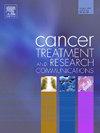乳腺乳头状瘤肿瘤的预后和临床结果:一项观察性研究
IF 2.4
Q3 Medicine
引用次数: 0
摘要
目的探讨乳腺乳头状癌的临床病理特点、治疗及预后。材料和方法检索Ramathibodi医院2010年1月1日至2020年1月31日所有乳腺乳头状病变的组织病理学报告,共544例。在133例(24.44%)组织病理证实的乳头状病变中,411例(75.55%)病变因组织病理类型混合而被排除在本研究之外。记录患者的临床特征,包括年龄、绝经期、临床表现、是否有肿块、是否有可疑钙化。记录诊断及肿瘤特征,包括免疫组化、肿瘤诺丁汉分级、病理分期。记录局部和全身治疗,包括手术类型、化疗、放疗、抗激素治疗和靶向治疗。预后包括总生存期和无病生存期。结果133例乳头状病变中,浸润性实性乳头状癌47例,浸润性包封性乳头状癌7例,实体性乳头状癌31例,包封性乳头状癌27例,浸润性乳头状癌16例,导管内乳头状癌5例。平均随访64个月,发现6例复发。此外,2例患者出现非癌症相关死亡。各类型患者无病生存率(DFS)差异无统计学意义,均为95.49%。结论乳腺乳头状癌是一种罕见的乳腺肿瘤变体。所有乳头状癌,包括浸润型,预后良好。我们认为浸润性乳头状癌是一种预后良好的亚型,因此可以减少相应的治疗。本文章由计算机程序翻译,如有差异,请以英文原文为准。
Prognosis and clinical outcome of papilloma neoplasm of the breast: An observational study
Objective
due to rarity of this subtype, the aim of this study was to investigate the clinicopathological features, treatment, and prognosis of papillary carcinoma of the breast.
Materials and methods
The histopathologic reports of all papillary breast lesion from January 1, 2010, to January 31, 2020, at Ramathibodi hospital were retrieved, comprising a total of 544 reports. Of the 133 (24.44%) histopathologically proved papillary lesions, 411 (75.55%) lesions were excluded from this study due to mixed histopathologic type. The clinical characteristics including age, menopausal status, clinical presentation, the presence of mass, presence of suspicious calcification were recorded. Diagnostic and tumor characteristics including immunohistochemistry, Nottingham grade of tumor, pathological stage were recorded. Local and systemic treatment including type of surgery, chemotherapy, radiation therapy, anti-hormonal therapy and targeted therapy were recorded. Prognosis including overall and disease-free survival were recorded.
Results
Of 133 papillary lesions, 47 lesions were invasive solid papillary carcinoma, 7 lesions were invasive encapsulated papillary carcinoma, 31 lesions were solid papillary carcinoma, 27 lesions were encapsulated papillary carcinoma, 16 lesions were invasive papillary carcinoma, and 5 lesions were intraductal papillary carcinoma. The mean follow-up period was 64 months, during which we identified 6 cases of recurrence. Additionally, non-cancer-related deaths were observed in 2 patients. There was no significant difference in disease free survival (DFS) among all types, with a rate of 95.49%. Similarly, overall survival (OS) showed no significant difference, with a rate of 98.5%
Conclusion
Papillary carcinoma is a rare variant of breast tumor. All papillary carcinomas, including the invasive types, exhibit an excellent prognosis. It is suggested that invasive papillary carcinoma should be considered a subtype with a favorable prognosis, allowing for minimization of treatment accordingly.
求助全文
通过发布文献求助,成功后即可免费获取论文全文。
去求助
来源期刊

Cancer treatment and research communications
Medicine-Oncology
CiteScore
4.30
自引率
0.00%
发文量
148
审稿时长
56 days
期刊介绍:
Cancer Treatment and Research Communications is an international peer-reviewed publication dedicated to providing comprehensive basic, translational, and clinical oncology research. The journal is devoted to articles on detection, diagnosis, prevention, policy, and treatment of cancer and provides a global forum for the nurturing and development of future generations of oncology scientists. Cancer Treatment and Research Communications publishes comprehensive reviews and original studies describing various aspects of basic through clinical research of all tumor types. The journal also accepts clinical studies in oncology, with an emphasis on prospective early phase clinical trials. Specific areas of interest include basic, translational, and clinical research and mechanistic approaches; cancer biology; molecular carcinogenesis; genetics and genomics; stem cell and developmental biology; immunology; molecular and cellular oncology; systems biology; drug sensitivity and resistance; gene and antisense therapy; pathology, markers, and prognostic indicators; chemoprevention strategies; multimodality therapy; cancer policy; and integration of various approaches. Our mission is to be the premier source of relevant information through promoting excellence in research and facilitating the timely translation of that science to health care and clinical practice.
 求助内容:
求助内容: 应助结果提醒方式:
应助结果提醒方式:


